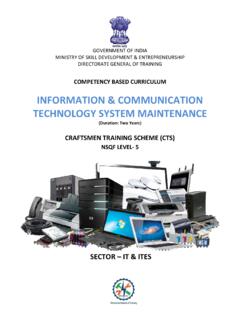Transcription of UM1713 User manual - STMicroelectronics
1 May 2015 DocID025731 Rev 41/411UM1713 User manualDeveloping applications on STM32 Cube with LwIP TCP/IP stackIntroductionSTMCube is an STMicroelectronics original initiative to ease developers life by reducing development efforts, time and cost. STM32 Cube covers STM32 portfolio. STM32 Cube Version includes: The STM32 CubeMX, a graphical software configuration tool that allows to generate C initialization code using graphical wizards. A comprehensive embedded software platform, delivered per series (such as STM32 CubeF4 for STM32F4 series) The STM32 Cube HAL, an STM32 abstraction layer embedded software, ensuring maximized portability across STM32 portfolio A consistent set of middleware components such as RTOS, USB, TCP/IP, Graphics All embedded software utilities coming with a full set of STM32 microcontrollers feature a high-quality 10/100 Mbit/s Ethernet peripheral that supports both Media Independent Interface (MII) and Reduced Media Independent Interface (RMII) to interface with the Physical Layer (PHY).
2 When working with an Ethernet communication interface, a TCP/IP stack is mostly used to communicate over a local or a wide area user manual is intended for developers who use STM32 Cube firmware on STM32 microcontrollers. It provides a full description of how to integrate a free middleware TCP/IP stack using STM32 Cube HAL drivers into an embedded application based on STM32 microcontroller. The middleware TCP/IP stack is the LwIP (Lightweight IP) which is an open source stack intended for embedded dedicated STM32 Cube firmware package is provided for each series. It includes Ethernet HAL driver, LwIP middleware and application examples with and without RTOS running on ST evaluation boards. Note:This document is applicable to all STM32 series featuring an Ethernet peripheral. However, or simplicity reason, STM32F4xx and STM32 CubeF4 are used as reference platform. The same description, file names and screenshot are applicable as well to other series offering Ethernet connectivity, such as STM32F107xx, STM32F2x7xx and STM32F7xx.
3 To know more about the Ethernet examples implementation on your STM32 series, refer to the documentation provided within the associated STM32 Cube firmware package. Rev 4 Contents1 LwIP TCP/IP stack description .. features .. architecture .. stack folder organization of the .. API overview .. API .. API .. API .. buffer management .. buffer structure .. management APIs .. 122 Interfacing LwIP with STM32 Cube Ethernet HAL driver .. 143 LwIP configuration .. support .. configuration .. 164 Developing applications with LwIP stack .. in standalone mode using the Raw API .. model .. of TCP echo server demonstration .. with an RTOS using Netconn or Socket API .. model .. of a TCP echoserver demonstration using the Netconn API . 235 LwIP package description .. package directories .. settings .. interface configuration .. and IP address settings.
4 Features .. 27 DocID025731 Rev 43 boards settings .. 276 Using the LwIP applications .. started applications .. echo client .. Echo server .. echo client .. echo server .. TCP echo server based on netconn AP .. applications .. server based on raw API .. server based on netconn API .. server based on socket API .. applications .. server .. 377 Conclusion .. 38 Appendix A FAQ .. do I choose between static or dynamic (DHCP) IP address allocation? .. does the application behave when the Ethernet cable is disconnected? .. can the application be ported on a different hardware? .. 398 Revision history .. 40 List of tablesUM17134/41 DocID025731 Rev 4 List of tablesTable Raw API functions .. 9 Table Raw API functions .. 10 Table API functions .. 10 Table API functions.. 11 Table API functions .. 13 Table interface functions description .. 14 Table memory configuration.
5 16 Table applications categories .. 28 Table revision history .. 40 DocID025731 Rev 45/41UM1713 List of figures5 List of figuresFigure architecture .. 8 Figure 2 LwIP folder organization .. 8 Figure structure .. 12 Figure operation model .. 18 Figure operation model with RTOS.. 22 Figure echo client .. 29 Figure echo server .. 30 Figure echo client .. 31 Figure echo server .. 32 Figure server home page .. 34 Figure use in HTTP server .. 35 Figure server list of task page .. 36 Figure tool (tftpd32) .. 37 LwIP TCP/IP stack descriptionUM17136/41 DocID025731 Rev 41 LwIP TCP/IP stack Stack featuresLwIP is a free TCP/IP stack developed by Adam Dunkels at the Swedish Institute of Computer Science (SICS) and licensed under a modified BSD focus of the LwIP TCP/IP implementation is to reduce RAM usage while keeping a full scale TCP/IP stack. This makes LwIP suitable for use in embedded comes with the following protocols: IPv4 and IPv6 (Internet Protocol v4 and v6) ICMP (Internet Control Message Protocol) for network maintenance and debugging IGMP (Internet Group Management Protocol) for multicast traffic management UDP (User Datagram Protocol) TCP (Transmission Control Protocol) DNS (Domain Name Server) SNMP (Simple Network Management Protocol) DHCP (Dynamic Host Configuration Protocol) PPP (Point to Point Protocol) ARP (Address Resolution Protocol)LwIP has three application programming interfaces (APIs): Raw API is the native LwIP API.
6 It enables the development of applications using event callbacks. This API provides the best performance and optimized code size, but adds some complexity to application development. Netconn API is a high-level sequential API that requires a real-time operating system (RTOS). The Netconn API enables multithreaded operations. BSD Socket API: Berkeley-like Socket API (developed on top of the Netconn API)The source code for the LwIP stack can be downloaded from LicenseLwIP is licensed under the BSD license. Below is a copy of the LwIP license document that is included in the source codes:/* * Copyright (c) 2001-2004 Swedish Institute of Computer Science. * All rights reserved. * * Redistribution and use in source and binary forms, with or without modification, * are permitted provided that the following conditions are met: * * 1. Redistributions of source code must retain the above copyright notice, * this list of conditions and the following Rev 47/41UM1713 LwIP TCP/IP stack description40 * 2.
7 Redistributions in binary form must reproduce the above copyright notice, * this list of conditions and the following disclaimer in the documentation * and/or other materials provided with the distribution. * 3. The name of the author may not be used to endorse or promote products * derived from this software without specific prior written permission. * * THIS SOFTWARE IS PROVIDED BY THE AUTHOR ``AS IS'' AND ANY EXPRESS OR IMPLIED * WARRANTIES, INCLUDING, BUT NOT LIMITED TO, THE IMPLIED WARRANTIES OF * MERCHANTABILITY AND FITNESS FOR A PARTICULAR PURPOSE ARE DISCLAIMED. IN NO EVENT * SHALL THE AUTHOR BE LIABLE FOR ANY DIRECT, INDIRECT, INCIDENTAL, SPECIAL, * EXEMPLARY, OR CONSEQUENTIAL DAMAGES (INCLUDING, BUT NOT LIMITED TO, PROCUREMENT * OF SUBSTITUTE GOODS OR SERVICES; LOSS OF USE, DATA, OR PROFITS; OR BUSINESS * INTERRUPTION) HOWEVER CAUSED AND ON ANY THEORY OF LIABILITY, WHETHER IN * CONTRACT, STRICT LIABILITY, OR TORT (INCLUDING NEGLIGENCE OR OTHERWISE) ARISING * IN ANY WAY OUT OF THE USE OF THIS SOFTWARE, EVEN IF ADVISED OF THE POSSIBILITY * OF SUCH DAMAGE.
8 * * This file is part of the lwIP TCP/IP stack. * * LwIP architectureLwIP complies with the TCP/IP model architecture which specifies how data should be formatted, transmitted, routed and received to provide end-to-end communications. This model includes four abstraction layers which are used to sort all related protocols according to the scope of networking involved (see Figure 1). From lowest to highest, the layers are: The link layer contains communication technologies for a single network segment (link) of a local area network. The internet layer (IP) connects independent networks, thus establishing internetworking. The transport layer handles host-to-host communications. The application layer contains all protocols for specific data communications services on a process-to-process TCP/IP stack descriptionUM17138/41 DocID025731 Rev 4 Figure 1. LwIP LwIP stack folder organization of the When unzipped, the LwIP stack files can be found under \Middlewares\Third_Party\ 2.
9 Figure 2 LwIP folder organizationwheredoc contains documentation text filessrc contains source files of the LwIP stackapi contains Netconn and Socket API filescore contains LwIP core filesinclude contains LwIP include filesnetif contains Network interface filessystem contains LwIP port hardware implementation filesarch contains STM32 architecture port files (used data types,..)OS contains LwIP port hardware implementation files using an operating systemnoOS contains LwIP port hardware implementation files in Standalone modeDocID025731 Rev 49/41UM1713 LwIP TCP/IP stack LwIP API overviewAs mentioned above, three types of APIs are offered by LwIP stack: Raw API Netconn API Socket Raw APIThe Raw API is based on the native LwIP API. It is used to develop callback-based initializing the application, the user needs to register callback functions to different core events (such as TCP_Sent, TCP_error.)
10 The callback functions are called from the LwIP core layer when the corresponding event b l e 1 provides a summary of the Raw API functions for TCP applications. Table 1. TCP Raw API functions API functionsDescriptionTCP connectionsetuptcp_newCreates a new TCP PCB (protocol control block).tcp_bindBinds a TCP PCB to a local IP address and the listening process on the TCP PCBtcp_acceptAssigns a callback function that will be called when new TCP connection the LwIP stack that an incoming TCP connection has been to a remote TCP TCP datatcp_writeQueues up data to be a callback function that will be called when data are acknowledged by the remote queued data to be TCPtcp_recvSets the callback function that will be called when new data be called when the application has processed the incoming data packet (for TCP window management).Application pollingtcp_pollAssigns a callback functions that will be called periodically.


















